Nila Parly investigates a major new cycle on DVD
The Cry of the Valkyrie: Feminism and Corporality in the Copenhagen Ring
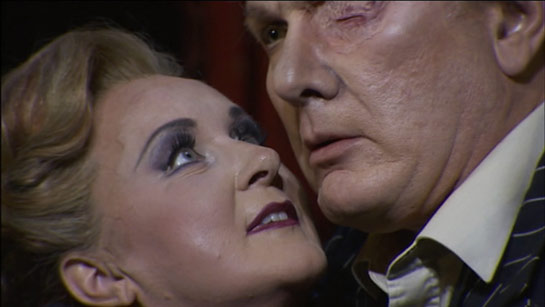
This review of The Copenhagen Ring on DVD has previously been published in The Wagner Journal Vol 3, no 2, 2008. Reprinted with permission.
A personal mythology
"A woman enters an attic and strikes a match. She is Brünnhilde – looking back into her past to understand her life just when the self she thought she knew has come to an end. She is in the midst of the worst crisis of her entire life, having just betrayed the man she loves more than anything in the world. Now she wants to find out how it came to this. She wants to understand herself: to create her own mythology, her own framework for understanding the life she has led. Thus begins our staging of Wagner’s Der Ring des Nibelungen; thus begins Das Rheingold. We start with the end rather than the beginning, and the entire Ring is experienced as one big flashback. We journey with Brünnhilde through her past and watch her attempt to cobble together the remnants of her life into something meaningful, a tool she can use.
Along with Brünnhilde we journey through the 1920s and 1930s in Das Rheingold, in which the great ideological structures are raised, until we reach the 1950s in Die Walküre, where the Cold War has frozen those structures into fortresses through which the great powers zealously guard each other in excruciating anticipation. Siegfried brings us to 1968, where the eponymous young hero naively rebels against his father’s rules and ideals, until the fin de siècle joy he expresses in Götterdämmerung comes to an abrupt end in a clash with pure evil of the type seen in Bosnia or Rwanda."
Kasper Bech Holten, ‘Mythologies:
An Introduction to Das Rheingold’,
in the first booklet
accompanying the Decca DVD edition of the Copenhagen Ring, 11–14.
This is how the director, Kasper Bech Holten, opens his introductory description in the first of the four booklets issued with Decca’s new Ring edition. In the Copenhagen production the character inspiring identification is no longer the naive youth, Siegfried, or the manipulating father figure, Wotan. Now it is a woman’s turn, and Brünnhilde naturally steps up to the front line. She has actually always been there, according to Wagner’s score: it is only onstage and in the scholarly literature that she has been overshadowed by the men. (Ibid., 13)
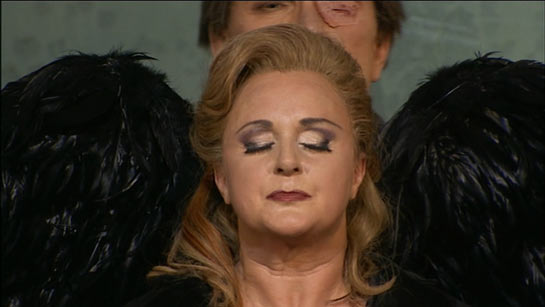
As the audience of the Copenhagen Ring, we see and experience everything filtered through Brünnhilde’s reminiscing personality. The effect of this is that parts of the immense contrasts in the Wagnerian narrative, which are otherwise often felt as ostentatious Sturm und Drang from a bygone epoch, all of a sudden become very natural, very recognisable, very topical, because in a moment of remembrance some – on the surface rather small – events may acquire mythological dimensions in connection with other memories, while other things are remembered with sober precision. The production takes advantage of these differences by switching gears between the soberly remembered parts, which are played out in a normal scale, and the dreamy, unrealistic, blown-up moments, which Brünnhilde herself experiences as ’mythological’.
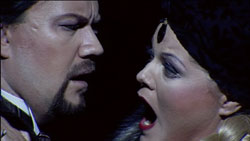
The effect of the stage shifts from realistic scenes, played in small, claustrophobic rooms, to the mythological scenes, played in vast, infinite locations, is somewhat lost in the DVD version; but on the other hand, the strong and very detailed character direction and the high tempo of the action are perfectly suited to the film medium. On DVD one never doubts that Das Rheingold is also a product of Brünnhilde’s memory, because we see her face in close-up on a split screen during all the orchestral interludes, while she attempts to guess the continuity in the fragmented family history she finds in the scrapbooks in the attic.
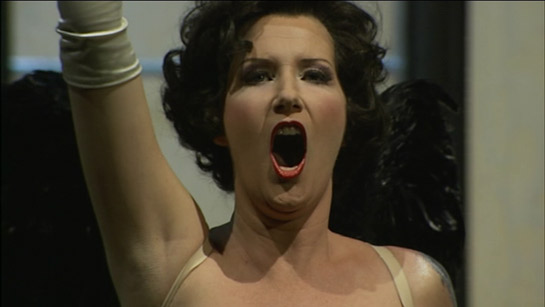
Cameras and characters
The DVDs were shot live at the Copenhagen Opera, but because of the 6-8 cameras that were placed in the wings, the flies and the prompt box, we see the singers at very close range; and their characterisations hold, even when they are playing to the back seats. The camera angle from the prompt box is quite extreme; sometimes it adds a beneficial twist to the depiction of ‘reality’, sometimes it seems just an unnecessary mannerism. All in all, however, there’s a good balance between close-ups and totals.
The conductor, Michael Schønwandt, took part in the development of this production from the very beginning and contributed significantly to the almost seamless welding together of acting and musical expression, which is one of the secrets behind the success. On the DVDs one hears how he brings out the narrative lines in the middle voices of the orchestra, so often sacrificed to more conspicuous effects. He has been cultivating a truly beautiful Wagnerian sound with the strings of the Royal Danish Orchestra, but his aim has not been beauty for beauty’s sake; his rendition of the Fire Music at the end of Die Walküre, for instance, is no floating, ravishing legato, but a more accentuated, flame-like sound, the ‘wabernde Lohe’ (flickering blaze) that Wotan conjures up.
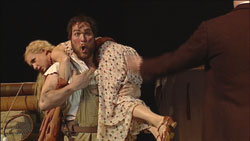
Almost all the singers come from the Royal Danish Opera’s own ensemble, with James Johnson’s ‘elder’ Wotan an exception; the youthful Wotan in Das Rheingold is sung by Johan Reuter. Both are more than adequate. Stephen Milling is impressive in two very different roles, a clumsy and lovelorn Fasolt and a chillingly dominant Hunding. Randi Stene gives the embittered Fricka a sharpness of character without any shrillness of voice, and Susanne Resmark creates an amazing Erda with true erotic glow in a massive body. Stig Andersen sings both Siegmund and Siegfried with his characteristic combination of bel canto and occasional declamatory outbursts, and his dramatic, often comic, talent ensures that neither of them is made into an unequivocal hero.
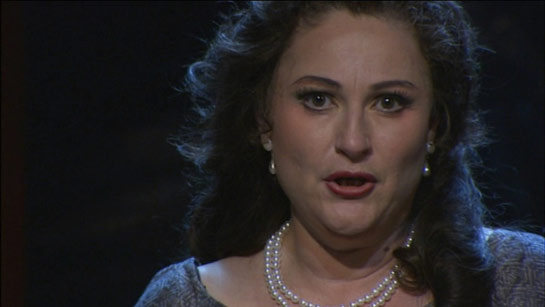
Iréne Theorin is also a fine actress, who occasionally, with the aid of the director and the conductor, touches the sublime. In terms of sound, she is the perfect Brünnhilde, able to sing the most delicate piano passages without the slightest wavering, but also to outbid her adversaries through sheer volume when this is called for – a great asset, since she plays the leading role in a feminist production which does all it can to emphasise the strength that Brünnhilde commands.
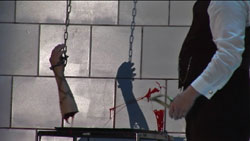
The long love duet between Siegfried and Brünnhilde at the end of Siegfried often looks like a singers’ contest onstage. The poor tenor is up against heavy odds and risks being swept completely off the field. He has been singing almost uninterruptedly during the first two acts, whereas the soprano’s voice is absolutely fresh and crisp, as she has only just been awakened. Thus, it is implicit in Wagner’s work that Brünnhilde will outdistance her male counterpart vocally by several lengths, and she is to perform this feat again repeatedly, not least in the Oath Scene in Götterdämmerung. The unequal battle is obvious in this production, too, and it is rather an advantage that Stig Andersen in the role of Siegfried does not display an all-powerful Wagnerian voice, which would have blocked the impression of the poetic, soft, teenage aspect that the character-direction does so much to underline.
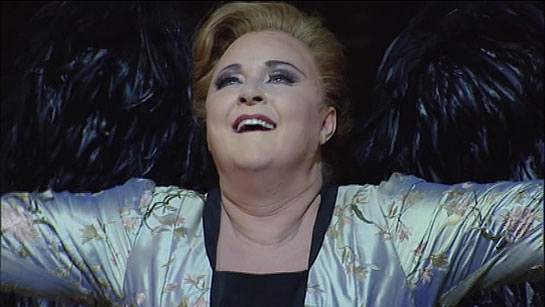
In this way Theorin achieved a vocal triumph in the live performance, asserting herself through her prodigious vocal capacity. Of course the Copenhagen Ring DVD does not give us the same overwhelming experience of the strength of her voice, but through close-ups we experience something else, namely how her body works while it produces all these magnificent sounds. Her open mouth, her sweat, her tongue come into focus in a way that almost oversteps the acceptable limits for scenes of a sexual nature.
Plagiarism or eclectisism?
It has become ever more common – and transparent – that directors recycle ideas from other directors’ productions, and the Copenhagen Ring is no exception: it borrows unashamedly. So if you have no time for more than one Ring DVD from the 21st century, take this one for a whistlestop tour of them all. The chief dramaturg of the Royal Danish Opera, Henrik Engelbrecht, has published a book in Danish about the whole progress towards the staging of the RDO’s first complete house production of Wagner’s Ring since 1912; among other information, it contains excerpts from the blog which the director kept on the Internet before and during the rehearsals. Bech Holten, who is also the artistic director of the Royal Opera, does not conceal the fact that other productions have influenced the final version of the Copenhagen Ring. He himself mentions how, during the concept-developing phase, he was making the circuit of live performances of the Ring in Zurich, Bayreuth, Seattle, Geneva and Stuttgart to find inspiration for the Danish production. (Kasper Bech Holten’s blog, Thursday, 14 June 2001, in Henrik Engelbrecht, Brünnhildes Ring: Wagners ’Nibelungens Ring’ på Det Kongelige Teater 2003–2006 (Copenhagen, 2004), 73.)
Judging from the final result, the Stuttgart production has probably been the most important source of inspiration. There are a few striking coincidences, such as the old-fashioned loudspeaker used to amplify the voice of the dragon Fafner, which looks like an exact copy of the one used by director Jossi Wieler in his Siegfried. This idea was indeed almost too good not to be reused, especially because Wagner’s own stage direction says that Fafner’s voice must be heard ‘durch ein starkes Sprachrohr’ (through a strong speaking-trumpet); the amped-up, ramped-up voice was conceived by Wagner as a part of the grisly tone character of the dragon. And the inspiration from Wieler goes beyond the stage design: it has even entered the details of the character direction, as when Wotan in the third act, precisely as he did in Stuttgart, fondly embraces the head of the young Siegfried, and the hero reacts with disgust at the far too long, too intimate contact. But what are these borrowings, then – simple plagiarism, or rather a kind of postmodern eclectisism? They are a sign of globalisation, I suppose, and of a tendency to recognise the fact, brought about by Regietheater, that the importance of other productions is as great for a director as the score is.
The borrowed elements are, however, very elegantly integrated into this production, and of course there are lots of original ideas that Bech Holten had prepared already or formed during rehearsals – the impressive black ‘death angel’ wings of the Valkyries, for instance. And bringing Hagen onstage as a youngster, before he is actually called for in the score, was another original idea – though after fostering it, Bech Holten went to Bayreuth only to discover that Jürgen Flimm had had the same idea and put it onstage a bit earlier. Bad luck.
The Copenhagen Ring is probably the funniest production I have witnessed. When the demi-god of fire, Loge, portrayed here as an incredibly unsavoury tabloid reporter with a greasy comb-over and a fish-like pout, constantly has to borrow Wotan’s lighter to light his own cigarette, it is hard to stop the corners of your mouth twitching; and when the Norns in the Prologue to Götterdämmerung, costumed as reactionary Wagnerites, stand up one by one among the audience and start grouching about the Regietheater concept of the production, angrily pointing at a photograph of the director in the programme, it has me, at least, rolling in the aisles.
But make no mistake, seriousness is lurking just around the corner, and very palpably so. This is not a Ring for people with delicate nerves. Already in Das Rheingold we see Alberich tearing the heart out of a naked male swimmer, who represents the Rhinegold, and a little later it is Alberich’s own turn to be bloodily tormented, when Wotan amputates his entire forearm in a torture chamber to get hold of the coveted ring, which in this production is a helix-shaped bangle. In Götterdämmerung, Hagen’s men are not hunting boars but shooting terrified prisoners of war in the backs of their heads, and in the last minutes of the opera, Hagen is not just drowned in a spot of blue light: he is burnt to death in live flames. In his attempt to rake the ring out of the funeral pyre, his whole arm catches fire, and he dashes about, desperately trying to put it out, until the stagehands pity the poor stuntman and let him down through a trap to the waiting firefighters.
Brünnhilde as the main character of the Ring
It has long been customary to view Wagner’s female characters and other opera heroines as victims, because the women, as a rule, perish during the plot of the opera. (This view spread fast after the anthropologist Catherine Clément’s book L’opéra, ou La défaite des femmes (1979) was translated into English by Betsy Wing as Opera, or the Undoing of Women (Minneapolis, MN, 1988).)A closer study of the music of the women – their singing and the orchestral voices that surround them – reveals, however, that most of the time it is actually the female characters who have the new and groundbreaking musical material, and that the women are far more in command of the development of the works than a superficial view will show.
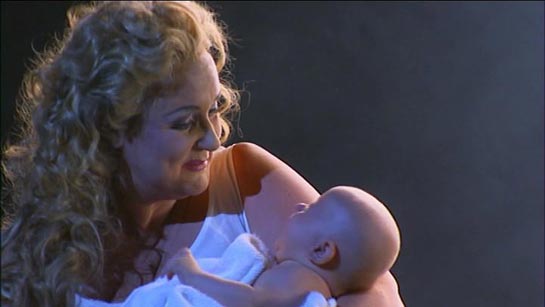
At the end of the Ring cycle Wotan is no longer in command. He sits silently waiting for someone to light the suicidal bonfire he has asked the gods to build around Valhalla. He is still the god of the gods, of course, but his personality has crumbled, and his daughter has to bring the work to closure, following her own mind. She lights Siegfried’s pyre, sends Loge, the god of fire, to Valhalla to destroy it, and finally leaps into the pyre herself to be burnt up with her beloved, ‘self-created’ hero. Brünnhilde’s final words about her self-sacrifice are, to be honest, not really in line with the modern feminist idea of a strong, independent woman. But does listening to the score not make you feel that the voices of the music somehow contradict her words? The American scholar Carolyn Abbate has made a very fine analysis of this scene in the last chapter of her book Unsung Voices (Carolyn Abbate, ‘Brünnhilde Walks by Night’, Unsung Voices: Opera and the Narrative in the Nineteenth Century (Princeton, NJ, 1991), 206–49.), where she points out that Brünnhilde delivers her more or less self-repressing words about Siegfried to the music of her own long-forgotten heroic Valkyrie music, thereby reviving her own divine strength. That might explain some of the contradiction; the power of the dramatic soprano’s voice no doubt accounts for the rest.
Performance studies as the analytical key to this Ring
In performance studies, there is a direct focus on the performative as a practice which produces meaning of itself. Performative theoreticians have shifted the concept of ‘the work’ from something ‘textual’ (the score) towards something ‘performative’ (the individual performance). The object of examination is usually a live event. Scholars like the German academic Erika Fischer-Lichte have made it their trademark to discuss the interaction between the players onstage and the audience in the auditorium, and this focus prepares the ground for a broader cultural-sociological perspective than reception aesthetics, for instance, have been able to provide. (Erika Fischer-Lichte, Ästhetik des Performativen (Frankfurt am Main, 2004) and Theatre, Sacrifice, Ritual: Exploring Forms of Political Theatre (New York, 2005).)
This is of course not possible when the examined object is a DVD; here the audience in front of the screen cannot affect the singers in any way, but that does not prevent one from focusing on other aspects typical of performance studies. While I personally do not find it particularly interesting to pin down what something means, it is much more intriguing to examine how meaning is brought about and experienced in vocal and stage practice, and to try to discern how the aesthetic guidelines laid down in the scores of Wagner are reshaped in this non-identical repetition of the work. This is exactly the method which performance studies suggests. Sometimes it may even come as a surprise to the directors how powerful these seemingly ephemeral elements are, and how they are perceived by the performers themselves. The following clip from Kasper Bech Holten’s ‘director’s blog’ is included in order to zoom in on the experience of voices and bodies at close range:
Today we had our dress rehearsal at 12 o’clock with me as Siegfried. Yes, me! Peter and Guido are both well again and Ylva’s health is slowly improving. Unfortunately Stig is now ill. I hope though that he will be ready for the premiere on Sunday. But we decided to spare him from singing today.
We didn’t have the time to find another Siegfried (now we have found a standby for the premiere on Sunday) but it seemed a little grotesque that my assistant, Mette should play his role – so I played the part myself. I promised not to sing though. Instead [the conductor] Michael Schønwandt sang from time to time. It was a strange feeling standing on stage and, of course, this had never worked out at a real performance. To me it was a quite extraordinary experience. It’s a crazy way to complete the Ring.
I can definitely find traces of a self-portrait in both the character Siegfried and in the production as a whole. To me it was funny playing Siegfried. I’m sure it must have looked quite awkward and confused, but I decided to just let go and play the part no matter what. It was a strong experience getting the chance to give expressions to all the emotions – especially performing the death scene felt quite extraordinary to me.
Being close to the actors and to feel and experience the sweat, the sound and the intensity is fantastic. What looks so calm among the audience feels really intense on stage; the concentration all around before entering the stage, how incredibly loud it sounds when Irene sings while you lie with your head on her stomach, playing dead feeling how everything is evolving around you, and to look up in the lights and to feel this special magic going on at stage. I really had an extraordinary experience today! It almost went to my head – I don’t really feel like taking the ring off my arm ever again :).
(The Copenhagen Ring: Artistic Director Kasper Bech Holten’s Blog on the Upcoming Event at the Copenhagen Opera House: ‘Dress Rehearsal’, Thursday, 16 Feb. 2006.)
Corporality in opera
On the Walküre DVD there is half an hour of bonus material, consisting of an enthusiastic conversation between Her Majesty Queen Margrethe and the director of the Copenhagen Ring. The Queen has attended several performances of this Ring, which makes her what you might call a highly qualified member of the audience. The two of them cover a lot of ground in their cordial discussion of the staging, and the conversation becomes particularly interesting when they reach the moment where Wotan tears off Brünnhilde’s black Valkyrie wings and makes her a mortal woman. Here, Bech Holten says, ’This turned into the proudest moment for me’, and the Queen answers: ’This really hit the audience at gut level. It startled you when he did that. Not least because Iréne Theorin and Tina Kiberg [the alternating Brünnhilde singer] did it so splendidly.’ The Queen is onto something essential here. It is an emotional, but also a purely physical, climax for the audience.
Bech Holten has chosen to show as physical pain the inner pain that Brünnhilde feels at being expelled from the society of the gods. This happens at the exact moment when the black wings are torn off. But Brünnhilde’s pain is not unambiguous. The expectant concentration in which she collects herself, while Wotan lifts up his arms to perform the decisive ‘operation’, reveals that her imminent pain will be mixed with joy. She is about to undergo a rite of passage – one pressed upon her against her will, true enough; but she is certain, having persuaded Wotan to put the ring of fire around her, that this rite will lead her to an emancipated life with a man of her own choice. She chooses to meet her fate with an open mind, long before Wotan even considers doing anything like that. The excitement in Brünnhilde’s face follows the increasing intensity of the music with remarkable precision, and at the very top of the musical surge her cry cuts through the orchestral texture. Her last wail as a child is one with her first cry as a woman. Her joyful pain spreads to our bodies, and we are purified, reborn, redeemed through her example. Brünnhilde’s cry already grants us catharsis here, at the conclusion of Die Walküre, so why should we concern ourselves with her death in Götterdämmerung?
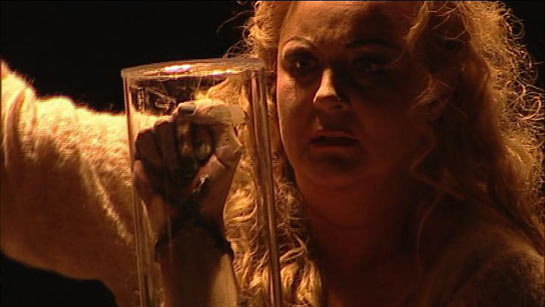
Forgiveness
Forgiveness is emphasised as a central aspect of Brünnhilde’s character in the Copenhagen production. Towards the end of the Ring Brünnhilde succeeds in forgiving three people, and the forgiving is mutual.
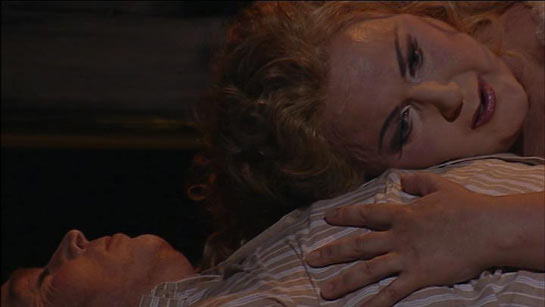
First, Siegfried, who does not die in the haze of his dream about his first love meeting with Brünnhilde, as tradition demands, but in the sole presence of the real, mature Brünnhilde. Then, Gutrune, who, having recognised the scope of the love between Brünnhilde and Siegfried, is given a measure of consolation and hope through physical contact with Brünnhilde, as their brows meet in a tender gesture of mutual understanding. And last, Wotan, who reaches for his daughter’s hand and obtains her absolution as she takes his and lovingly strokes his hair.
Siegfried’s Funeral March is the decisive turning point in this production: it is from here that Brünnhilde’s retrospection emanates. Here the magnificent Funeral Music is no longer just an expression of Wagner’s homage to the dead hero. Rather, it expresses the strong emotions aroused in Brünnhilde by Siegfried’s death and her own disgraceful part in it; the orchestral music lets us hear the personal landslide taking place within her, as she starts her journey back towards the ‘beginning’ of everything. When, at the same time and through the bookshelves in the attic, an impressive squadron of fighter planes is seen flying in formation, Brünnhilde’s inner emotions are put into perspective by an outward celebration of the heroic, which also refers to the music. This double exposure is, to my mind, nothing short of brilliant.
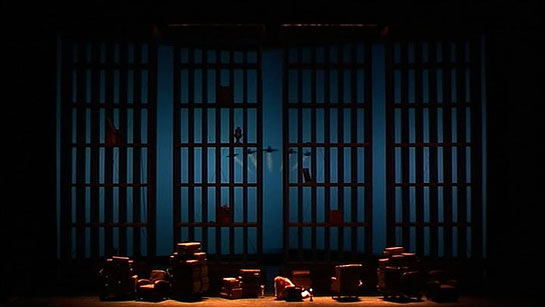
Brünnhilde now sets fire to the attic that contains her own complete past – and the complete past of this opera – and the fire consumes everything, from scrapbooks to family members. In the middle of the attic her father is sitting, slumped in an armchair with his back to the audience. Here the director has chosen to disregard Wagner’s stage direction about Wotan being seen consumed by flames high above the stage with the other gods. Nothing controversial in that. But he has also chosen to disregard the text that Brünnhilde sings, underscoring her standing on the bank of the Rhine while Wotan is in Valhalla: ‘Fliegt heim, ihr Raben! / Raunt es eurem Herren, / was hier am Rhein ihr gehört!’ (Fly home, you ravens! / Whisper to your lord / what you heard here by the Rhine!), which explicitly stresses the physical distance between her and her father. Only rarely is a staging idea good enough to justify the ignoring of a textual statement; in this case I even think that it adds a gestural depth which significantly increases the intensity in Wagner’s music drama. A crucial choice has been made. What is more important: text or music? Because they do not tell the same story. The text speaks of a vast distance, while the music speaks of the closest possible intimacy. Brünnhilde’s touching the old man’s body unfolds the basic substance of the music onstage in the most sublime way. This moment has closeness as its deepest undercurrent.
Brünnhilde confronts Wotan with his guilt:
erschaut eu’re ewige Schuld!
Meine Klage hör’,
du hehrster Gott!
Durch seine tapferste That,
dir so tauglich erwünscht,
weihtest du den,
der sie gewirkt,
dem Fluche, dem du verfielest: –
Mich – mußte
der Reinste verrathen,
daß wissend würde ein Weib!
[behold your eternal guilt! / Hear my lament, / most mighty of gods! / By the bravest of deeds, / which you dearly desired, / you doomed him who wrought it to suffer / the curse to which you in turn succumbed: – / it was I whom the purest man / had to betray, / that a woman might grow wise.]
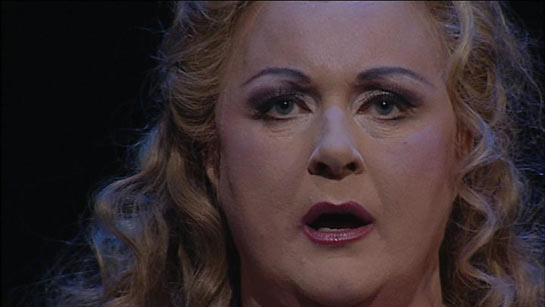
But she later forgives him, finally uttering: ‘Ruhe! Ruhe, du Gott!’ (Rest now, rest now, you god!) He no longer has to sit there as a withered ghost, tormented by his bad conscience; now, with his daughter’s blessing, he can cross the threshold to death and rest in peace. And her touching of his body generates a warmth which, I am sure, passes directly into the bodies of most people in the audience, especially the male listeners who have been identifying with Wotan’s contradictory character.
Redemption
In the Copenhagen Ring Brünnhilde also defies good old uncle Wagner’s last stage direction. Instead of throwing herself onto Siegfried’s funeral pyre and being burnt with him and the world of the gods, the pregnant woman chooses life at the last moment and goes offstage in labour, to give birth to her child. Again, the narrative of the music has been given precedence. Brünnhilde has, at the end of her great monologue, sung a motif which we have heard only once before in the whole Ring, the so-called Redemption motif. In Die Walküre, Sieglinde sang this simple and unusually beautiful motif as her response to Brünnhilde’s announcement that she, Sieglinde, was pregnant. The rare leitmotif has now been brought back by Brünnhilde in connection with her own pregnancy, and the orchestra takes over and concludes the whole Ring narrative with it. Wagner explained the meaning of it thus: ‘The motif sung by Sieglinde to Brünnhilde is the glorification of Brünnhilde, which at the end of the work will be taken up by the whole.’
According to Cosima Wagner in a letter dated 6 Sept. 1875, ‘das Motiv, welches Sieglinde der Brünnhilde zusingt, die Verherrlichung Brünnhilden’s ist, welche am Schluss des Werkes gleichsam von der Gesammtheit aufgenommen wird’. Stewart Spencer’s citation in Wagner, iv (1983), 90.)
The Ring ends, in other words, with a musical anachronism, pointing back to Sieglinde’s glorification of Brünnhilde, and this feminine leitmotif is finally absorbed in the orchestral music as in society as such.
Giving birth, Brünnhilde has irrevocably entered womanhood. The actual result of her transgressive love union with Siegfried is now presented as a tiny, living, newborn child – a real baby, not a doll – in the arms of a happy, totally engrossed mother. And the little girl (it is a girl, the director has declared) has a voice, too; she is wailing with a voice that carries far out into the auditorium. (Newborn babies have a natural placement of voice, relaxed vocal cords, and supple use of a strong diaphragm, something an adult singing student needs several years to get back to.)
Iréne Theorin has at this moment sung a dramatic monologue which lasts twenty minutes, quite a tour de force. This brings back the focus on the character’s physical achievement. Could it be the exertion of singing that has brought on the birth? Is it then, indirectly, Iréne Theorin’s singing that has thwarted Wagner’s plans to have her commit suicide? Be that as it may, through this – not only spiritual, but also corporal – redemption, a fusion of the semiotic and the phenomenological sphere is accomplished, which makes this ending immensely satisfying.
The cry of the Valkyrie echoes into the future.
Full cast
Das Rheingold
Johan Reuter (Wotan), Hans Lawaetz (Donner), Jonny van Hal (Froh), Michael Kristensen (Loge), Stephen Milling (Fasolt), Christian Christiansen (Fafner), Sten Byriel (Alberich), Bengt-Ola Morgny (Mime), Randi Stene (Fricka), Anne Margrethe Dahl (Freia), Susanne Resmark (Erda), Djina Mai-Mai (Woglinde), Ylva Kihlberg (Wellgunde), Hanne Fischer (Floßhilde)
Die Walküre
Stig Andersen (Siegmund), Gitta-Maria Sjöberg (Sieglinde), James Johnson (Wotan), Iréne Theorin (Brünnhilde), Stephen Milling (Hunding), Randi Stene (Fricka), Emma Vetter (Helmwige), Ylva Kihlberg (Gerhilde), Carolina Sandgren (Ortlinde), Hanne Fischer (Waltraute), Anna Rydberg (Siegrune), Elisabeth Jansson (Roßweiße), Elisabeth Halling (Grimgerde), Ulla Kudsk Jensen (Schwertleite). Bonus feature: HM Queen Margrethe II of Denmark meets Kasper Bech Holten, the director.
Siegfried
Stig Andersen (Siegfried), Bengt-Ola Morgny (Mime), James Johnson (Wanderer), Sten Byriel (Alberich), Christian Christiansen (Fafner), Susanne Resmark (Erda), Iréne Theorin (Brünnhilde), Gisela Stille (Woodbird)
Götterdämmerung
Stig Andersen (Siegfried), Guido Paevatalu (Gunther), Peter Klaveness (Hagen), Sten Byriel (Alberich), Iréne Theorin (Brünnhilde), Ylva Kihlberg (Gutrune), Anette Bod (Waltraute), Susanne Resmark (First Norn), Hanne Fischer (Second Norn), Anne Margrethe Dahl (Third Norn), Djina Mai-Mai (Woglinde), Elisabeth Meyer-Topsøe (Wellgunde), Ulla Kudsk Jensen (Floßhilde)
Royal Danish Orchestra/Michael Schønwandt, Kasper Bech Holten (director), Marie í Dali and Steffen Aarfing (set and costume design), Jesper Kongshaug (lighting). Recorded live at the Royal Danish Opera in May 2006; video production by Cubus Film and TV; Decca 074 3265/3266/3269/3272, 7 DVDs (148 mins, 229 + 36 mins, 240 mins, 267 mins)
More reviews
Some of Holten’s rewrites are more contentious, not only because they contradict Wagner, or at least add a heavy gloss to his original, but also because they limit rather than expand on what his work can signify. Wotan killing Loge with his spear at the end of Rheingold is one example, partly because it’s nonsensical, but also because it closes off the notion of the fire god abandoning his divine colleagues to become a freer agent. Hagen killing Alberich at the end of their scene in Götterdämmerung is another, because he’s the one major character whose fate is not clearly finished. Arguably, he’s a survivor of the catastrophe, with potentially further havoc to wreak. Maybe his possible continuance would have jarred with Holten’s optimistic mother-and-child end-image. If so, Wagner’s nagging doubt is surely preferable in its ambiguity.
[...]
Vocally, the main players are formidable, with Iréne Theorin’s accurate and tireless Brünnhilde an even match for Stig Andersen’s genuine Heldentenor contributions, which offer a sentient masculinity for Siegmund and a comprehensively commanding and physically youthful (except maybe in close-up) Siegfried. But he certainly looks nothing like 56, which was his actual age at the time, and his acting is as finely wrought as his singing. The Fricka, Loge, Alberich, Mime, Sieglinde, Hunding, Gunther and Gutrune would grace any production. Peter Klaveness does not supply an ideal bass gravitas for Hagen but he’s quite the nastiest exponent of the role one could encounter. This is a wonderful Ring to watch as well as to listen to, a must-have for Wagnerians anywhere.
George Hall, Opera Magazine
In brief, the musical side was an unequivocal success: Michael Schønwandt´s Royal Danish Orchestra sound was gloriously transferred to DVD, with even greater power and more lucidity than I remembered it from the live performances.
The singers were all excellent actors and looked their parts. Furthermore, the singing was never less than average and casting of many of the crucial characters were on the highest international level (Stephen Milling, Stig Andersen, Irene Théorin etc.).
However, the most controversial aspect of this Copenhagen Ring DVD release undoubtedly will be the actual filming, as The Copenhagen Ring approximates a film in its own right rather than a recording of a live operatic performance.
Mostly Opera
Der Ring des Nibelungen: Articles and Reviews
Nila Parly on Regietheater: Visions of the Ring
The Cry of the Valkyrie: Feminism and Corporality in the Copenhagen Ring
Sam Goodyear, Bayreuth 2022: Der Ring des Nibelungen (Valentin Schwarz)
Mark Berry, Bayreuth 2022: Das Rheingold (Valentin Schwarz)
Mark Berry, Bayreuth 2022: Die Walküre (Valentin Schwarz)
Mark Berry, Bayreuth 2022: Siegfried (Valentin Schwarz)
Mark Berry, Bayreuth 2022: Götterdämmerung (Valentin Schwarz)
Mark Berry: Bayreuth 2017: Das Rheingold (Frank Castorf / Marek Janowski)
Mark Berry: Bayreuth 2017: Die Walküre (Frank Castorf / Marek Janowski)
Mark Berry: Bayreuth 2016: Das Rheingold (Frank Castorf)
Mark Berry: Bayreuth 2016: Die Walküre (Frank Castorf)
Mark Berry: Bayreuth 2016: Siegfried (Frank Castorf)
Mark Berry: Bayreuth 2016: Götterdämmerung (Frank Castorf)
Mark Berry: Bayreuth 2014: Das Rheingold (Frank Castorf)
Mark Berry: Bayreuth 2014: Die Walküre (Frank Castorf)
Mark Berry: Bayreuth 2014: Siegfried (Frank Castorf)
Mark Berry: Bayreuth 2014: Götterdämmerung (Frank Castorf)
Per-Erik Skramstad: Bayreuth 2013: There Will Be Blood: Frank Castorf Has Entered the Ring
Per-Erik Skramstad: Bayreuth 2010: Curtain Down on Tankred Dorst's Ring
Mark Berry: 2010 Cassiers Ring
Sam Goodyear: Laufenberg’s Wiesbaden Ring 2017
Jerry Floyd: Rheingold, Metropolitan 2010
Jerry Floyd: Die Walküre, Metropolitan 2010
Jerry Floyd Washington National Opera: Siegfried
Jerry Floyd Washington National Opera: Siegfried II
Jerry Floyd Washington National Opera: Götterdammerung Concert (2009)
Jerry Floyd Washington National Opera: Götterdammerung Concert (2009)
Mark Berry: Richard Wagner für Kinder – Der Ring des Nibelungen (2011)




